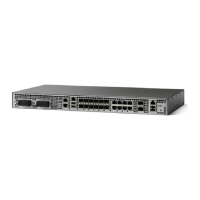Configuring the Router ID and Global ID
SUMMARY STEPS
1.
enable
2.
configure terminal
3.
mpls tp
4.
router-id node-id
5.
global-id num
6.
end
DETAILED STEPS
PurposeCommand or Action
Enables privileged EXEC mode.enable
Step 1
Example:
Device> enable
•
Enter your password if prompted.
Enters global configuration mode.configure terminal
Example:
Device# configure terminal
Step 2
Enters MPLS-TP configuration mode, from which you can configure
MPLS-TP parameters for the device.
mpls tp
Example:
Device(config)# mpls tp
Step 3
Specifies the default MPLS-TP router ID, which is used as the default
source node ID for all MPLS-TP tunnels configured on the device.
router-id node-id
Example:
Device(config-mpls-tp)# router-id
10.10.10.10
Step 4
(Optional) Specifies the default global ID used for all endpoints and
midpoints.
global-id num
Example:
Device(config-mpls-tp)# global-id 1
Step 5
•
This command makes the router ID globally unique in a multiprovider
tunnel. Otherwise, the router ID is only locally meaningful.
•
The global ID is an autonomous system number, which is a controlled
number space by which providers can identify each other.
MPLS Basic Configuration Guide, Cisco IOS XE Everest 16.5.1 (Cisco ASR 900 Series)
20
MPLS Transport Profile
Configuring the Router ID and Global ID

